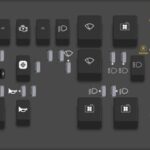Connecting to and flashing your PCM can be a frustrating experience. This guide outlines how to troubleshoot common issues when using WinFlash with an OBD2 LS1 engine for tuning. We’ll cover cable selection, software setup, and connection verification to help you successfully flash your new tune file.
Common WinFlash OBD2 LS1 Connection Problems
Many enthusiasts encounter problems connecting to their PCM despite having the necessary cables and software. You might see data in diagnostic software like EEHack, allowing you to view live data and perform basic tests. However, tuning software like TunerPro RT or FlashHack may not connect, preventing you from reading or writing tune files. This often manifests as unresponsive “connect” or “run” buttons within the software.
One common issue stems from using the wrong type of cable. While a standard ALDL cable might work for basic diagnostics, it likely won’t suffice for flashing. You’ll need a specific OBD1 to OBD2 cable designed for flashing, often with a built-in FTDI chip. These cables typically have three LEDs: power, RXD (receive data), and TXD (transmit data). A solid power LED and a flashing TXD LED during attempted connection usually indicate proper cable functionality.
Incorrect COM port selection within the tuning software can also cause connection failures. Double-check your device manager to confirm the correct COM port assigned to your flashing cable.
Setting Up WinFlash for OBD2 LS1
To successfully use WinFlash, ensure you have the correct hardware and software. You’ll need a reliable OBD1 to OBD2 flashing cable, a laptop with a working COM port (or a USB to serial adapter), and the WinFlash software. Additionally, you’ll need the correct definition files for your specific PCM.
Begin by connecting your flashing cable to the OBD2 port of your vehicle and the other end to your laptop. Verify the cable’s LEDs indicate power and data transmission activity. Next, open WinFlash and select the appropriate COM port and PCM definition file. If using a USB to serial adapter, ensure the drivers are correctly installed.
Before attempting to flash a new tune, try reading the existing bin file from your PCM. A successful read confirms proper communication between the software, cable, and PCM. If the read fails, review your cable connection, COM port settings, and software configuration. Consult the WinFlash documentation and online forums for specific troubleshooting steps related to error codes or messages.
Flashing Your LS1 PCM with WinFlash
Once a successful connection is established, flashing your new tune file is relatively straightforward. Within WinFlash, select the option to write or flash a new bin file. Choose the tune file provided by your tuner and initiate the flashing process.
It’s crucial to ensure a stable power supply during the flashing process. Avoid interrupting the process, as this could corrupt the PCM and require professional recovery. Once the flash is complete, WinFlash will typically confirm successful completion. You can then verify the new tune by reading the PCM again and comparing it to the flashed file.
If you continue to experience difficulties, consult online resources dedicated to LS1 tuning, or contact your tuner for specific guidance related to your vehicle and tune file. Proper preparation and understanding of the process are key to a successful PCM flash. Remember to always back up your original bin file before making any changes.

